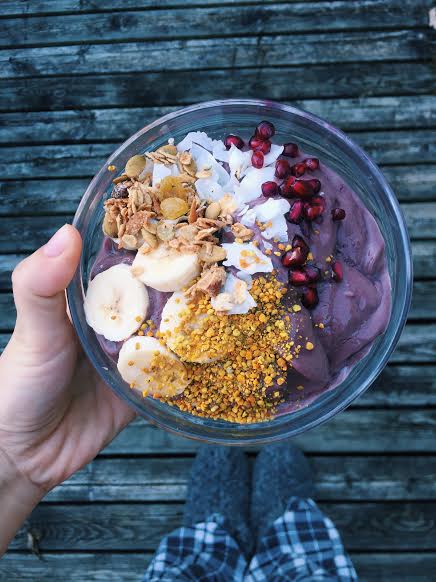Not to be too reductive about it, but pegan is probably the dumbest name for a diet in the world. The word is a combination of two conflicting food ideologies: the Paleo diet, which requires followers to eat copious amounts of meat and animal fat while avoiding complex carbohydrates like legumes, and veganism, which strongly petitions for the opposite. The idea is that pegans eat a diet that is part paleo, and part vegan. At first the concept doesn’t make any sense, essentially suggesting that a pegan lifestyle consists of simply eliminating dairy—the only food group largely prohibited in both diets. It’s enough to make you think, let’s just call it what it is: another food-intolerant diet for those who aren’t food intolerant.
But the pegan diet’s ideology, despite its ridiculous name, actually comes from a very mindful place. One of the main benefits from the diet is that followers are encouraged to make 75% of their food choices from nutrient rich plant-based sources, with the main objective of using meat and animal products as a condiment rather than a main. This acceptance of meat and animal products as an aside is a concept that I believe is an important part of moving towards a sustainable food future. While there are the health concerns that come with consuming some types of meat, brought to light recently by the World Health Organization, human health is not the only thing affected by animal agriculture.
It is proven that the amount of meat and animal products we eat in North America is not environmentally sustainable over the course of the long-term. If we keep consuming meat and animal products at our current rate, we will suffer major environmental repercussions in our lifetime. Animal agriculture is responsible for 18% of greenhouse gas emissions – more than the combined exhaust from all transportation. Livestock and their byproducts account for at least 32,000 million tons of carbon dioxide (CO2) per year, or 51% of all greenhouse gas emissions.
These are nothing short of staggering facts that demand attention. If a trendy diet like peganism can help move people away from consuming as much meat and animal products, then I believe it’s worth some consideration.
There is also the fact that, whenever I have flirted with veganism or paleo dieting in the past in moderation, I have always felt healthy. It’s when I’ve taken either of these diets too far to one extreme that I’ve felt less than spectacular. Maybe combining aspects of the two—eating more high-quality plant-based foods and avoiding processed sugars and starches—could lead to some rewards.
The rules of peganism essentially boil down to eating the following: mostly plants, good fats, a little meat, gluten free whole grains occasionally, and considering the glycemic load of your meals (i.e., combining good fats with carbohydrates to not spike your blood sugar too much at one time). Followers are instructed to avoid conventional dairy and instead look for goat or sheep milk products, which have higher levels of vitamins and minerals and are easier to digest (and always buy organic when possible).
The guidelines to peganism read more like suggestions that are open to interpretation, rather than a strict or rigid eating plan that inevitably feels like a slow motion nose-dive into an a box of double-stuffed Oreos.
Taking these guidelines into account, I spent three days adopting peganism as my own. I focused on vegetables and high quality grains in lieu of meat and animal products. Highlights include a millet bowl with avocado, kimchi, kelp noodles, and shredded carrot from Bolt, an acai bowl with homemade granola, and a kale and spinach salad with a bit of grass-fed steak on top. I still ate meat and a little bit of goat’s cheese, which was nice as I never felt like I was depriving myself, but the amount of animal products in my diet was dramatically smaller than usual.
I cannot tell you that I did not miss pasta, toast, and ice cream deeply—the way I imagine people who get over things easily feel when someone unfollows them on Instagram. I know that eliminating these lifelong loves forever—no matter the alleged health benefits involved—is never going to be the life I want to live. I also don’t believe that (unless you are allergic) gluten is the devil it has been purported to be. Call it selective listening.
However, I am convinced that there is something to be said for peganism and the idea of moving meat and animal products to the side of our diets, rather than letting them take center stage. Meat is delicious and an entirely different sensory experience from any other food, and asking people to eliminate them entirely is not going to happen, at least not in my lifetime. While I know it is causing great environmental distress on our planet, I also know that I am selfish enough to continue eating it for years to come. I don’t think I’m alone in this fact. This is why I am confident that adopting some aspects of a pegan diet—mainly making our meals plant-based rather than meat based—is an extremely sustainable and appealing dietary shift that we should be capable of completing.
I would recommend peganism to anyone trying to make a sustainable change in his or her diet. If you want to know more about adopting meat as a condiment to help the environment, you can read more about it in Dan Barber’s book The Third Plate: Notes on the Future of Food.
Verdict: While I know subscribing to the label of a diet can be problematic, I will continue trying to adopt concepts of peganism into my life and hope others will too. Also, whoever named it should probably be fired.



 Follow Us On Instagram
Follow Us On Instagram
